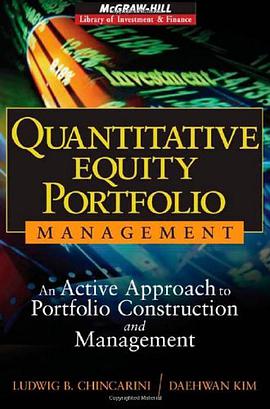Quantitative Equity Portfolio Management 豆瓣
作者:
Ludwig B Chincarini
/
Daehwan Kim
McGraw-Hill
2006
- 7
Praise for Quantitative Equity Portfolio Management "A must-have reference for any equity portfolio manager or MBA student, this book is a comprehensive guide to all aspects of equity portfolio management, from factor models to tax management." ERIC ROSENFELD, Principal & Co-founder of JWM Partners "This is an ambitious book that both develops the broad range of artillery employed in quantitative equity investment management and provides the reader with a host of relevant practical examples. The book excels in melding theory with practice." STEPHEN A. ROSS, Franco Modigliani Professor of Financial Economics, Massachusetts Institute of Technology "The book is very comprehensive in its coverage, detailed in its discussions and written from a practical perspective without sacrificing needed rigor." DAVID BLITZER, Managing Director and Chairman, Standard & Poor's Index Committee "Making the transition from the walls of academia to Wall Street has traditionally been a difficult task!This book provides this link in a successful and engaging fashion, giving students of finance a road map for the application of financial theories in a real-world setting." MARK HOLOWESKO, CEO and Founder, Templeton Capital Advisors "This text provides an excellent synthesis of a broad range of quantitative portfolio management methods!In addition, there are a number of insightful innovations that extend and improve current techniques." DAN DIBARTOLOMEO, President and Founder, Northfield Information Services, Inc. Capitalize on Today's Most Powerful Quantitative Methods to Construct and Manage a High-Performance Equity Portfolio Quantitative Equity Portfolio Management is a comprehensive guide to the entire process of constructing and managing a high-yield quantitative equity portfolio. This detailed handbook begins with the basic principles of quantitative active management and then clearly outlines how to build an equity portfolio using those powerful concepts. Financial experts Ludwig Chincarini and Daehwan Kim provide clear explanations of topics ranging from basic models, factors and factor choice, and stock screening and ranking!to fundamental factor models, economic factor models, and forecasting factor premiums and exposures. Readers will also find step-by-step coverage of portfolio weights! rebalancing and transaction costs!tax management!leverage! market neutral!Bayesian _!performance measurement and attribution!the back testing process!and portfolio performance. Filled with proven investment strategies and tools for developing new ones, Quantitative Equity Portfolio Management features: A complete, easy-to-apply methodology for creating an equity portfolio that maximizes returns and minimizes risks The latest techniques for building optimization into a professionally managed portfolio An accompanying CD with a wide range of practical exercises and solutions using actual historical stock data An excellent melding of financial theory with real-world practice A wealth of down-to-earth financial examples and case studies Each chapter of this all-in-one portfolio management resource contains an appendix with valuable figures, tables, equations, mathematical solutions, and formulas. In addition, the book as a whole has appendices covering a brief history of financial theory, fundamental models of stock returns, a basic review of mathematical and statistical concepts, an entertaining explanation and quantitative approach to the casino game of craps, and other on-target supplemental materials. An essential reference for professional money managers and students taking advanced investment courses, Quantitative Equity Portfolio Management offers a full array of methods for effectively developing high-performance equity portfolios that deliver lucrative returns for clients. About the Authors Ludwig B. Chincarini, Ph.D., CFA, is a professor of finance at Georgetown University as well as a financial consultant to institutional investors. Previously, he was director of research at Rydex Global Advisors, the index mutual fund company. Prior to that, Dr. Chincarini was director of research at FOLIOfn, a brokerage firm that pioneered basket trading. He also worked at the Bank for International Settlements and holds a Ph.D. in economics from the Massachusetts Institute of Technology. Daehwan Kim, Ph.D., is a professor of economics at the American University in Bulgaria. Previously, he was employed as a financial economist for FOLIOfn. Dr. Kim also worked as a financial journalist, writing regular columns on financial markets for business media in Asia. He also holds a Ph.D. in economics from Harvard University.

